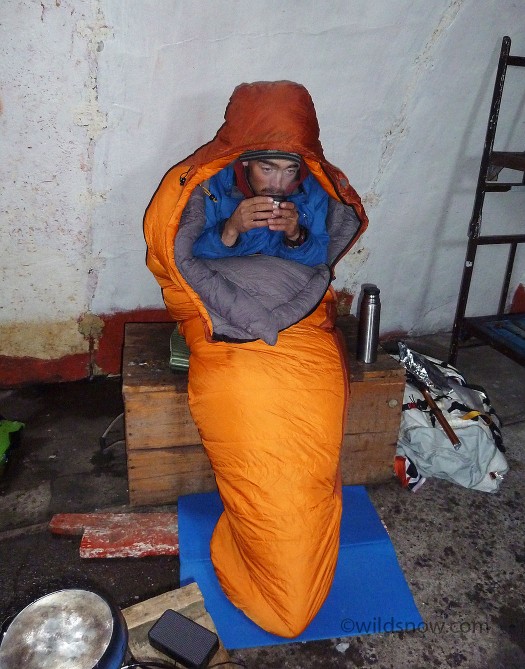I haven’t owned a down sleeping bag for a few years now, being willing to carry the extra weight of a synthetic bag in order to reap the benefits. For backcountry shelter I usually use a lightweight Megamid tent, or a bivy sack, both of which don’t protect my sleeping bag from 100% of the elements. Therefore it’s nice to have water-resistant insulation.
I’ve had my latest synthetic bag for about six years. Consequently it is worn out. What once was a zero degree bag is now probably closer to a 15, although with a few extra layers I’m able to make it work. Yes, synthetic fill deteriorates — especially when forced through hundreds of tight compression cycles.
For my recent trip to South America, I didn’t know what to expect as far as sleeping arrangements, or what the temperatures were going to be. To be prepared for the worst I wanted a warm sleeping bag, but I also knew I’d need all the help I could get to stay under those 50 pound baggage limits. I decided to acquire a new down bag.
I settled on the Mountain Equipment Glacier 1000, a -15° celcius (5° farenheit) bag. Mountain Equipment has been selling sleeping bags in the States for a little over a year, although they’ve been making nice sacks for quite a while on the other side of the Atlantic. Fun to check out a new brand.
The Glacier 1000 has 1000 grams of 675+ down (click here for more than you ever wanted to know about that). The total weight comes in at 1650 grams (3.63 lbs), on the hefty side for down bags, but still light, and I wanted a heavier-duty, durable bag for traveling. It also has water-resistant shell fabric, something I definitely wanted in a down bag. Other features include a full-length zipper, draft collar, and an anatomical footbox.
I got the new bag a day before I flew out and quickly packed it up. It wads down fairly small, especially compared to my old synthetic bag. I chose to use a lightweight dry-sack instead of the included compression sack. Unfortunately by the time the airport got done with it, the dry-sack had a big rip in the side. Oh well, so much for that plan.
A few days after arriving in South America we camped at a low elevation. It wasn’t very cold, but dew covered us every morning. The shell fabric got damp, but it kept out most of the moisture. The down would get a bit wet if I stuffed the sleeping bag before drying out the wet exterior. Although the temps at that camp were too high for a 5 degree bag, the full side zip kept me comfortable. Down bags definitely have a comfy, fluffy feeling, and the Glacier 1000 also features an extra-soft lining that enhances that.
Throughout the trip I spent thirty nights in the Glacier 1000. I slept in a variety of situations: beds, floors, warm huts, cold huts, camping in the open, and everything in between. Although we didn’t encounter super cold temps, it was nice to have the warm bag just in case. A few nights got chilly, and we also encountered some fairly windy conditions (it was southern South America after all). The water resistant shell also does an admirable job of keeping out the wind, something that can make any sleeping bag chilly. I wasn’t cold once, at least after being in the bag for a few moments to warm up. (Mountain Equipment bags are made to the EN 13537 standard which ensures they are as warm as they say.)
Another reason for down bags is durability. A synthetic bag, while cheaper, will invariably wear out after a few years. Down, however, will keep it’s loft for decades if it’s cared for correctly. The Glacier 1000 has a fairly durable fabric exterior, while the interior is a softer, more fragile fabric, although still adequately durable. The build quality of the bag is superb which is a huge factor with longevity.
There were of course a few cons with the bag as well. The major one for me was the draft collar. I don’t find myself using draft collars a whole lot, but when you are right at the temperature limit of the bag they can be useful. The draft collar in the Glacier 1000 has a weak elastic drawstring. Although this makes it more comfortable and less restricting, it also decreases the usefulness of the collar. I found I couldn’t tighten it enough to effectively block airflow, somewhat negating the purpose. Also, the Glacier 1000 is an all-around bag, a good value that you can use for lots of styles of trips. Yet consequently it is a little heavier than some down bags of equal warmth. If you’re looking for an ultralight bag, this one isn’t it but Mountain Equipment makes several series of bags, some lighter and some with more weather proof options.
My first trip using a down bag in six years didn’t leave me soaked and frozen. The Glacier 1000 lightened my pack and handled a variety of conditions in South America. I think it will hold up well to the harsh North Cascade winter as well. I’m looking forward to testing it out in those conditions.
Louie Dawson earned his Bachelor Degree in Industrial Design from Western Washington University in 2014. When he’s not skiing Mount Baker or somewhere equally as snowy, he’s thinking about new products to make ski mountaineering more fun and safe.


